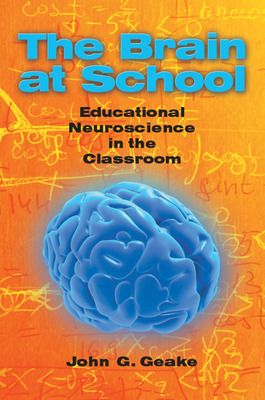The Brain at School: Educational Neuroscience in the Classroom
Receive via shipping:
- Colour, print bound version of the complete text
A case for educational neuroscience
Caveats and disclaimers
CHAPTER 1: WHY EDUCATIONAL NEUROSCIENCE?
Education neuroscientific research questions
Limits to educational neuroscience
CHAPTER 2: NEUROIMAGING TECHNOLOGIES
CHAPTER 3: LEARNING AND MEMORY
Individual brains
Hebb's model of learning through synaptic plasticity
Memory
CHAPTER 4: WORKING MEMORY AND INTELLIGENCE
Working memory
Attention
Intelligence
Gifted and talented pupils
Sex differences
Genetics of intelligence
IQ scores as a measure of social evolution
CHAPTER 5: CREATIVITY AND IMAGINATION
Fluid analogising
Creative intelligence
Imagination
CHAPTER 6: SOCIALISING, EMOTION AND MOTIVATION
Mirror neurons and socialising
Emotion
Motivation and self-esteem
Attention Deficit Hyperactivity Disorder
CHAPTER 7: LANGUAGE AND LITERACY
Language
Story telling
Literacy
Dyslexia
Second language learning
CHAPTER 8: NUMERACY AND MATHEMATICS
Arithmetic
Statistics
Fractions
Algebra and geometry
Mathematical thinking
Mathematical creativity
CHAPTER 9: ARTS CURRICULUM
Music
Visual arts
CHAPTER 10: A FUTURE FOR EDUCATIONAL NEUROSCIENCE
Schools of the future
An agenda for educational neuroscience
Last word
Professor Martin Westwell, Director, Flinders Centre for Science Education in the 21st Century, Flinders University, Australia
Within education there is a growing interest in neuroscience research and what it can teach us. This book focuses on what neuroscience means for education professionals - in key areas such as learning, memory, intelligence and motivation - and addresses questions such as:
- How does the brain enable us to learn?
- Why do some children have learning difficulties, such as ADHD or dyslexia?
- How can actual scientific research be applied to pedagogy and curriculum design
This friendly book is jargon-free and no prior scientific knowledge is assumed of the reader. It is thought-provoking reading for practising teachers across all age ranges, trainee teachers, parents, head teachers, educational policymakers, academics and educational psychologists.

